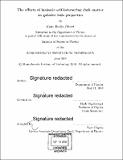The effects of inelastic self-interacting dark matter on galactic halo properties v/
Author(s)
Dibert, Karia Radh
DownloadFull printable version (2.901Mb)
Other Contributors
Massachusetts Institute of Technology. Department of Physics.
Advisor
Mark Vogelsberger.
Terms of use
Metadata
Show full item recordAbstract
Self-interacting dark matter, which serves as an alternative to collisionless cold dark matter, may be useful for solving the small-scale galaxy formation problems present in the Lambda-Cold Dark Matter model. So far, most self-interacting dark matter simulations have considered only elastic collisions between particles. Using the results of a numerical implementation in the AREPO code, the effects of two-state inelastic dark matter on the density profiles, velocity dispersions, pseudo-phase-space density profiles, orbital anisotropy parameter profiles, and principal axis ratios of galactic halos are examined. We find that inelastic self-interacting dark matter halos differ from both cold dark matter halos and elastic self-interacting dark matter halos in density profiles, in velocity dispersion profiles, in pseudo-phase-space density profiles, and in orbital anisotropy parameter profiles, while the shapes of the halos generated by elastic and inelastic self-interacting dark matter models are relatively similar.
Description
Thesis: S.B., Massachusetts Institute of Technology, Department of Physics, 2018. Cataloged from PDF version of thesis. Includes bibliographical references (pages 37-40).
Date issued
2018Department
Massachusetts Institute of Technology. Department of PhysicsPublisher
Massachusetts Institute of Technology
Keywords
Physics.